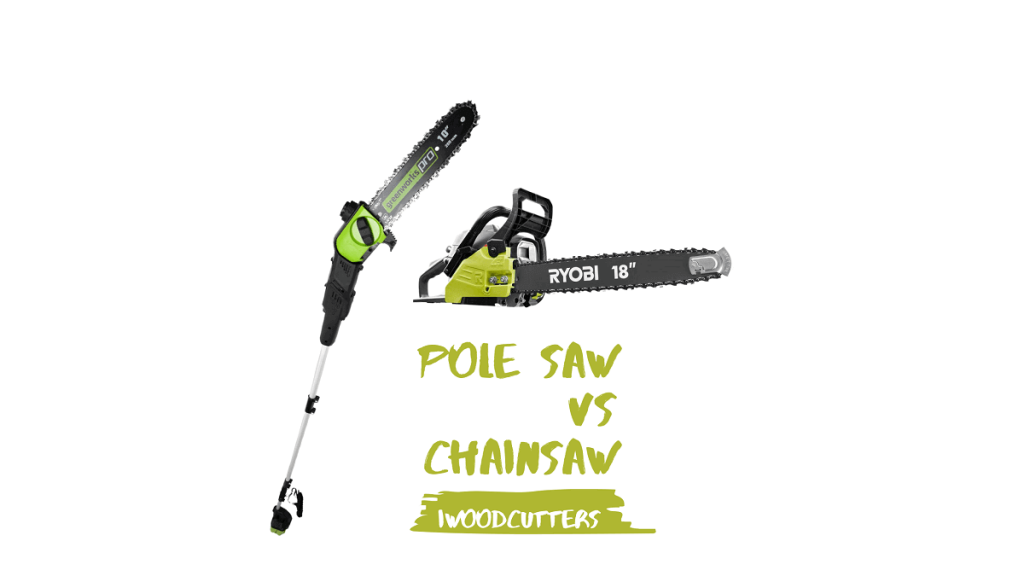If you have a green garden or yard in your home, you need to cut dry stalks and bushes all year round. There are various cutters to choose from for this job on the market these days, but in the end, the choice is a pole saw or chainsaw floating in our eyes on 2 tools. Today we will tell you the details about these two tools.
There are different types of chainsaw out there if you don’t know how they look and what they use it’s hard to distinguish between different designs a lot of inexperienced buyers have trouble understanding what a pole looks like. To clarify these issues, this guide will help you get the right idea about chainsaw vs pole saw.
Chainsaw Vs Pole Saw, What’s the difference?
The major difference between a chainsaw vs pole saw is their extent. The chainsaw is short and is used to work close to your body, to cut trees or bottom. A pole saw is long, like a chainsaw on a stick, and is mainly used to cut and pare at places you can not reach with your chainsaw.
A lot of people are intimate with chainsaws but many have little or no knowledge of saws as the pole saw. Pole saws and chainsaws have many common ardors as well as differences. This ardor and differences should be considered when you need to decide on which one to purchase.
Do you need to know the differences between these two saws? Do you want to know which one laws your garden best? Don’t look too far, we’ve taken you covered. This article will guide you through the topical things you need to know about a chainsaw or a pole saw.
What is a Chainsaw?
A chainsaw is a cutting dong that has teeth on a chain and is typically powered either by gas or an electric engine. The cutting chain is usually attached to the exhibit bar, it is mechanically powered to spin the chain. This cutting chain is responsible for cutting per wood.
Whether you’re felling trees, trimming large branches, or cutting firewood, a chainsaw is the fastest, most feasible way to cut wood. They can further be quite dangerous if you handle them carelessly.
Chainsaws are not only powered by gas, there are various electric chainsaws on the market too. They are generally smaller in size and are easier to handle, making them a great alternative for many. Chainsaws can perform their deed as a result of an internal combustion engine connected to the chain with sharp blades. The simple mechanism has a grown level of reliability. There are always two options to prime from.
Electric chainsaws, which are so powerful and multifunctional. In fact, you can conveniently use it for up to 15 hours a day without a break as long time as you have spare charged batteries
Gasoline chainsaws are a great option for casual use. The greatest benefit of gasoline chainsaws is that they are lightweight and small in size. Hence, they can be used to cut a small amount of firewood for igniting and burning a fire pit. The initial capability of a gasoline chainsaw is very limited so it is recommended that you use it for not more than 2 hours per day.
What is a Pole Saw?
As mentioned earlier, a pole saw is grandly described as a pruning saw attached to the end of a pole. Pole saws are great for trimming tree limbs and branches that are hard to come at. So instead of using a scale, getting the best pole saw is a better idea.
Just like the chainsaw, pole saws come in different types – manual, electric, and gas-force pole saws. A gas-force pole saw is like a chainsaw with an extension. They can be exempt dangerous but if you’ll be doing a lot of trimming, you may want to consider a power pole saw. Electric pole saws are easily powered when plugged in a power rope or connected to a battery pack.
Types of Pole Saw
Pole saws, like the standard chainsaws, are available in two basic types – the electric and gas-powered pole saw, everyone has its pros and cons. There are also manually pole saws but if you’re not a professional, you’ll probably have no use for one.
- Gas-Powered Pole Saw:
They are the most heavy-labor of all the pole saws. They are also very powerful, and the most popular choice for professional landscapers. Gas-powered pole saws are relatively easy to use, very mobile, and provide a great amount of cutting power that is versatile enough for different continuity. They have a gas-powered engine on one end, and a small chainsaw blade on the various. The length of the pole is mostly dependent on the model, but the minimum for most models is 6 feet, with some extending a little wherewithal.
Gas-powered pole saws are quite similar to gas weed eaters in the way they conduct. The engine style is originally the same, and so is the operation. You prime the engine, pull the cord to get the engine going, and then use a trigger to send different levels of power to the plate at the end. Apart from offering mobility, they are capable of operating for long periods within fuel refills. This is the major reason many professionals set up to use them.
- Electric Pole Saw
Just as the name suggests, electric pole saws are powered by electricity in place of gas. They are also of different types. Like their gas-powered counterparts, they have a mold similar to a weed eater. The only difference is that the engine does not rely on combustible fuel.
The sizes and reach of electric pole saws vary but assured professional models extend up to 6-10 feet. The engine portion of the saw is located on the bottom, which appends to a trigger that controls the speed of the blade.
Electric pole saws are of two categories, the corded and rayless models. Usually, it all comes down to the preference of the user because the two types don’t too much in size and power. However, the corded models have limitless power supply and are a bit more powerful, hence they are often suitable for people with average-sized yards that only need to cut down a few branches or two every now and then. Cordless pole saws, on the other hand, use a rechargeable battery crew.
These power packs have a limited amount of charge, so they can only be used for a brief period. Although they have the advantage of being fully mobile, the battery can fast run down before you know it. They are often less powerful than their tethered counterparts, but not always.
- Manual Pole Saws
Manual pole saws are simple yet efficient for various reasons. Without a need for an engine or a battery, manual pole saws can use longer poles for a too greater reach. They are also very easy to maneuver, even though they require a considerable volume of work to get the job done. Most professional landscapers and arborists have at least one manually saw on hand despite the popularity of the gas and electric models. Manual pole saws require dab to use. They usually have less damaging effects on their duties.
Types of Chainsaw
- Gas-powered Chainsaws
These tend to cut quickly and smoothly. Their fast chain speeds require less pressure from users to make clean cuts than some low-powered electric models, making them the best bet for heavy-duty work such as dropping large limbs and trees. However, most of them are heavier and noisier than electronic versions.
- Corded-electric chainsaws
Most electric saws have a plug-in power cord and cost less than gas-powered models. These usually weigh less and they all start effortlessly: just plug in them and press the trigger. However, the pace of their gradual success has limited them to light-duty tasks, such as making hedges or occasionally pruning small tree parts. Their power cord keeps you connected to the nearest electronic duct.
Conclusion
Eventually, we found out that the main difference between a chainsaw and a pole saw is their quantity. Chainsaws are also used to work very close to your body, to cut down trees, or to use the bottom. A pole saw, on the other hand, is long, like a chainsaw on a stick, and it is basically cut and used in places where you cannot reach with your own chainsaw.
The importance of these two tools in our daily life is immense. We know that Chainsaw vs Pole Saw, the difference between the two saws. You can choose what you need for your garden from here.

This is me Sonnet. I manage a full-time workshop for my clients’ woodworking projects. From a very young age, I’ve been always passionate about DIY projects. And that’s the reason I’m amicable with the woodworking tools. I’m regularly handling a couple of projects like cabinets, furniture, boats, and many more using wood, veneers, and laminates.
